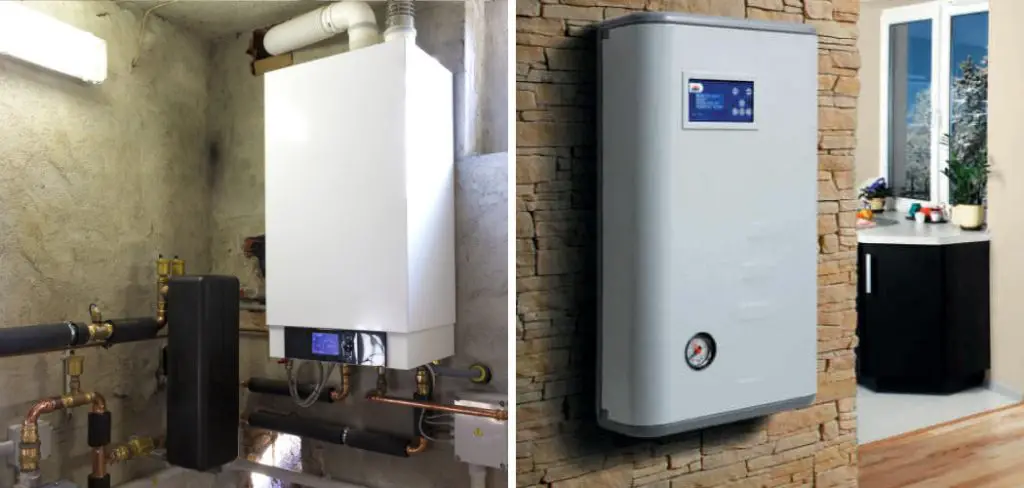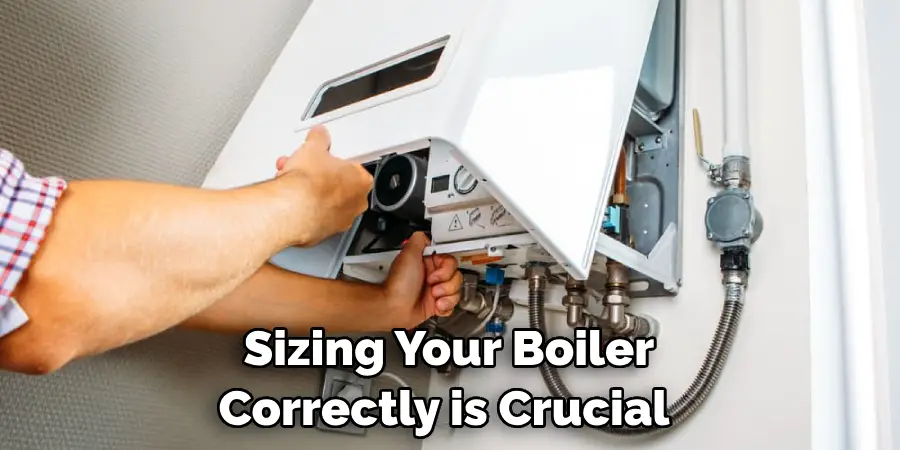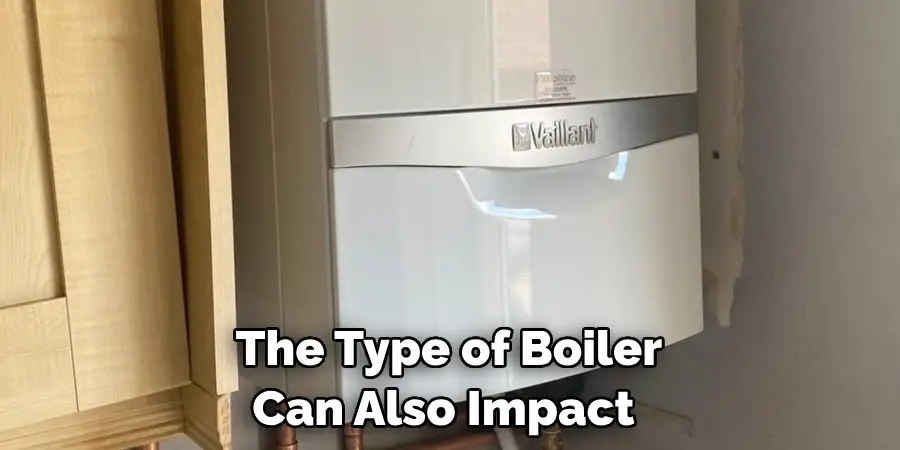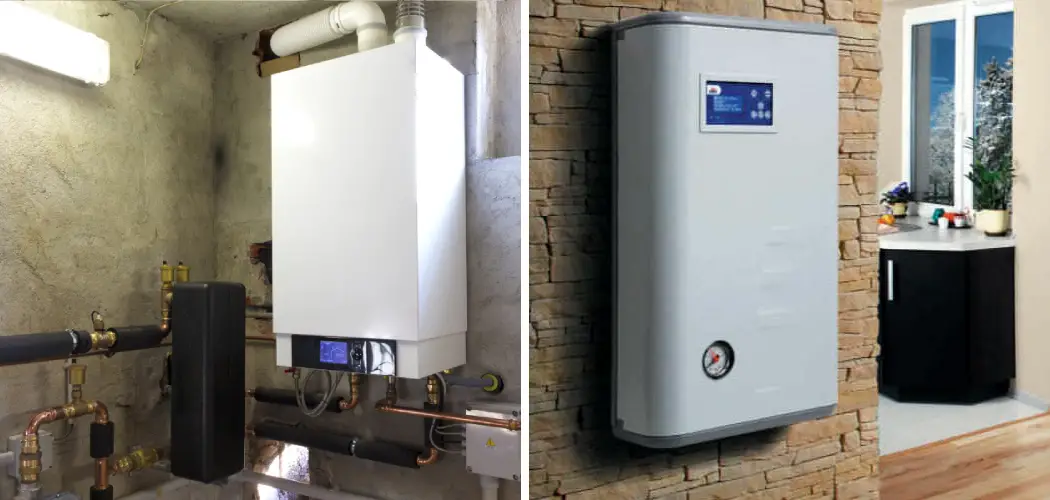You’re freezing in your drafty old home, and the heating hasn’t been working properly for years. It’s time to replace the old, unreliable boiler, but where do you even start? The process of sizing a new boiler can seem daunting, but don’t worry – help is here!

In this post on how to size a boiler for your house, I’ll walk you through the key factors to consider when calculating boiler size for your home, such as number of bedrooms, fuel source, climate, pipes, and more. By the end, you’ll have a clear understanding of how many BTUs you need so you can pick the perfect new boiler to keep your family cozy for years to come.
Let’s start so you can ditch those space heaters and enjoy toasty warmth!
What Will You Need?
Before we dive into the nitty gritty, you’ll need some key pieces of information to help you calculate your boiler size. These include:
- The square footage of your home
- Number and type of windows in your home (single or double pane)
- The insulation level of your walls and attic
- The number of bedrooms in your home
- Your location and climate
- The type of fuel source available in your area
Having these details on hand will make the sizing process much more manageable. If you don’t have them readily available, take some time to gather this information before proceeding.
What are the Benefits of Properly Sizing Your Boiler?
Sizing your boiler correctly is crucial for several reasons. First and foremost, an undersized boiler won’t be able to keep up with the demands of your home, leaving you shivering on chilly days. On the other hand, an oversized boiler will lead to wasted energy and higher utility bills. By properly sizing your new boiler, you can ensure that it is operating at maximum efficiency and providing the right amount of heat for your home.

Additionally, an appropriately sized boiler will have a longer lifespan as it won’t be constantly overworking to meet your heating needs. This means less frequent repairs and replacements, saving you even more money in the long run.
10 Easy Steps on How to Size a Boiler for Your House
Step 1. Gather Your Information:
As mentioned above, you’ll need to know the square footage of your home, the number and type of windows, the level of insulation, the number of bedrooms, your location/climate, and the type of fuel source available in your area. Gather all of this information before proceeding. Be careful to note any unique factors that may impact the BTU calculation.
Step 2. Calculate the Total Square Footage:
Begin by measuring each room in your home. For each room, multiply the width by the length to obtain the square footage. It may be helpful to sketch a rough home floor plan to keep track of your measurements. Remember to include all rooms – bedrooms, bathrooms, kitchen, living areas, and additional spaces such as basements or attics.
Once you have the square footage for each room, add all these numbers together. The result will be the total square footage of your home, an essential parameter when sizing your boiler.
Step 3. Determine BTUs per Square Foot:
Now that you have the total square footage of your home, it’s time to calculate the number of British Thermal Units (BTUs) required to heat each square foot. As a rule, 30 BTUs must heat one square foot of living space. To calculate this, simply multiply your total square footage by 30. The resulting number will provide a base BTU value needed to heat your home. Remember that this is just a starting point; other factors must be considered for an accurate BTU calculation.
Step 4. Adjust for Climate:
The next step is to adjust your base BTU value depending on your location and climate. If you live in a colder region, you’ll need more BTUs per square foot than someone in a warmer region. For example, homes in the Northeast of the United States, where winters can be particularly harsh, might require 50-60 BTUs per square foot. On the other hand, if you’re in a warmer climate, such as the Southern States, you may only need around 20-30 BTUs per square foot.
Factor in your specific environment by multiplying your base BTU value by your climate factor (for example, 1.5 for frigid climates, 1.25 for moderately cold climates, 1.0 for mild climates, and 0.75 for warm climates). The resulting figure will give you a more accurate estimation of the BTUs required to heat your home effectively.
Step 5. Consider Insulation:
Insulation plays a significant role in determining the size of your boiler. A well-insulated home will retain heat better, reducing the energy needed to maintain a comfortable temperature. On the other hand, an older home with poor insulation will require more BTUs per square foot to compensate for heat loss.
Depending on the level of insulation in your walls and attic, you may need to adjust your BTU calculation by 10-20% up or down. For example, you can deduct 10% from your final BTU calculation if you have excellent insulation. In contrast, if your home is poorly insulated, you may need to add 20%.

Step 6. Adjust for Windows:
The type and number of windows in your home can also impact your boiler size calculation. Windows are not as well insulated as walls, allowing more heat to escape. If you have single-pane windows, consider adding 20% to your BTU calculation, while double-pane windows may only require an additional 10%. This adjustment will ensure your boiler is sized correctly to compensate for heat loss through your windows.
Step 7. Factor in the Number of Bedrooms:
The number of bedrooms in your home can also affect the BTU calculation. Bedrooms typically require less heat than living areas, such as the kitchen or living room. Generally, you can deduct 10-15% from your final BTU calculation for each bedroom in your home.
Step 8. Consider Hot Water Requirements:
Many modern boilers come with the option to provide hot water on demand, eliminating the need for a separate water heater. If you choose to have this feature, you’ll need to add 10-15% to your final BTU calculation. This increase will account for the extra energy required to provide hot water throughout your home.
Step 9. Choose the Correct Fuel Type:
The type of fuel available in your area is also an essential factor when sizing a boiler. Different powers have different costs and energy efficiency ratings, so choosing the one that best suits your needs is crucial. For example, natural gas is often the most cost-effective option for heating homes. However, if you live in a remote area without access to natural gas, your options may be limited to propane or oil.
Step 10. Consult with a Professional:
While these steps can estimate the BTUs needed to heat your home efficiently, it’s best to consult a professional for a more accurate calculation. An HVAC specialist or boiler technician will have the expertise and knowledge to help you select the correct size boiler for your home based on your unique needs and requirements. They can also recommend energy-efficient options, provide installation services, and offer additional advice on maintaining your boiler’s performance.

By following these steps and considering all the relevant factors, you can ensure your new boiler is correctly sized for your home’s heating needs. An appropriately sized boiler will keep your home comfortable and save energy and reduce utility costs in the long run.
5 Additional Tips and Tricks
- Understand Your Heating Needs: Different homes have different heating requirements. Factors such as your home’s size, age, and insulation can significantly affect your heating needs. Make sure to assess these factors before deciding on a boiler size.
- Consult A Professional: While you can make a rough estimate of the boiler size you need, it’s always best to consult a professional. They have the knowledge and tools to perform a precise heat loss calculation.
- Consider Future Plans: If you plan on expanding your home, these additions will require more heating. Your current boiler size might need to be increased, so consider potential future expansions when sizing your boiler.
- Think About Efficiency: Bigger doesn’t always mean better. A too large boiler for your home can lead to energy inefficiency. Conversely, a boiler that’s too small will need more heat. Striking the right balance is vital.
- Boiler Type: The type of boiler can also impact the sizing. Combi boilers, system boilers, and regular boilers all come in different sizes. You need to choose the right type as well as the right size for your home.

With these additional tips and tricks, you’ll be better equipped to size a boiler for your house properly. Remember always to do your research and consult a professional for the best results.
5 Things You Should Avoid
- Avoid Guesswork: Never rely on guesswork when sizing a boiler for your home. Incorrect sizing could lead to poor performance and higher energy costs.
- Don’t Ignore Insulation: The level of insulation in your home can significantly influence the size of the boiler you need. Overlooking insulation could lead to over or under-sizing your boiler.
- Beware of Oversizing: Don’t fall into the trap of thinking that a giant boiler is always better. Oversized boilers can lead to increased energy consumption and higher bills.
- Avoid Cheap Service Providers: When consulting a boiler sizing professional, don’t opt for the cheapest service. Quality and expertise should be your primary considerations.
- Don’t Neglect Maintenance: Regular maintenance is essential to ensure optimum performance even with the right size boiler. Refrain from assuming that your job is done once your boiler is installed. Regular check-ups can prevent unexpected malfunctions and ensure your boiler operates efficiently.

By avoiding these common mistakes, you can ensure that your boiler is properly sized for your home and will operate efficiently.
How to Choose a Boiler?
When selecting a boiler for your home, consider the following factors:
- Size: As discussed earlier, understanding your heating needs and consulting a professional can help determine the right size for your home.
- Efficiency: Look for boilers with higher energy efficiency ratings. This will not only save you money on energy costs but also have a positive impact on the environment.
- Fuel Type: Boilers can run on different fuel types, such as gas, oil, or electricity. Consider the availability and cost of these fuel sources in your area.
- Brand and Model: Research different brands and models to find a reliable and reputable boiler that suits your needs. Check for warranties and customer reviews to make an informed decision.
- Installation Cost: The cost of installation can vary depending on the type and size of the boiler. Make sure to factor in this cost when budgeting for a new boiler.
- Maintenance and Service: Consider the maintenance and service requirements of different boilers. Some may require more frequent servicing than others, which could impact your overall costs.

By carefully considering these factors, you can choose the right boiler for your home that meets your heating needs and budget.
Conclusion
In conclusion, how to size a boiler for your house for your house is essential for effective heating and energy efficiency. By considering factors such as the size of your home, insulation levels, and hot water demand, you can determine the appropriate boiler size for your specific needs.
It is also essential to consult a professional to ensure proper sizing and installation. Remember, an appropriately sized boiler saves you money on utility bills and helps reduce your carbon footprint.
So don’t wait any longer; take the first step towards a more comfortable and eco-friendly home by sizing your boiler correctly today!
As the weather gets colder, now is the perfect time to take action and enjoy a warm and cozy winter season without breaking the bank. Together, we can positively impact both our wallets and our planet. Let’s go green while keeping our homes warm. Are you ready? We know we are!

